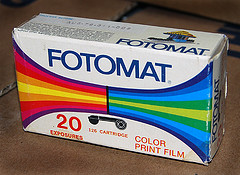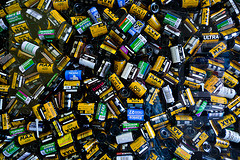Oh, no. I’m not ready to give up on the anti-planned-obsolescence rant just yet…

Digital, of course, was supposed to be the death knell of film, but things didn’t quite work out that way. Instead, digital photography sparked new public interested in photography as an art and hobby, which ended up leading a lot of folks back to film. Like the vinyl LP vs. CD debate, there are plenty of passionate photographers ready to argue that one or the other is inherently superior. As one of those people who never took a strong interest in photography until getting my first digital camera, my perspective is that is has less to do with better than different–qualitatively different.

The Rochester, NY Democrat and Chronicle recently published a story about a local business you might have heard of, that’s still hanging on to the film business: Kodak. The article quotes Kodak’s marketing manager for professional film, Scott R. DiSabato:
“We call it the ‘and’ world,” DiSabato said. “We know the professional use will be significant enough the next couple years, we’ll get the investment (into those film lines) back.”
In fact, Kodak introduced a new color film formulation this past year, a time when film still makes up a third of the company’s gross revenue.
Again, I’m not arguing against technological innovation. I have nothing against digital cameras, and I own several. I also own a pile of film cameras (that I picked up for next to nothing). I’m just pointing out again that obsolescence is a business process and a social process. That is, there’s nothing inherent in film that should make it obsolete, so much as that the combination of the need to find new products to sell, the fact that some of these new products actually do offer new and significant benefits and a social shift to embrace that new technology.
The social element is important–Kodak is still making and selling film because people are buying it and using it. They’re finding value in it, whether it’s due to nostalgia, the belief that it is superior to digital, an affinity for film’s aesthetics, or simply because using disposable film cameras when you need them makes more sense than dumping several hundred bucks into a digital cam.

Videotape, on the other hand, is reuseable. Certainly if all manufacture were to stop today eventually the tapes in use now would eventually wear out. But the true death of the medium would come more slowly than if film were to be no longer manufactured.
As (electronic and chemical) media makers we are still dependent on a consumer economy, but that doesn’t mean we are utterly subject to its whims, nor without feedback mechanism. We do not have to buy up every new so-called innovation because it’s supposed to be better, nor do we have to abandon a technique, method, medium or tool just because the industry, press or blogosphere now declares it dead. In fact, fantastic personal innovation, ingenuity and creativity can be sparked in the continued embrace, or reembrace of a reportedly obsolete technology. Whether it’s audiocassette, VHS, film, vinyl LP, laserdisc, minidsc, 8-track or daguerreotype, it’s not dead for you until you don’t want to use it any longer.
Thanks to Ken Rockwell, the most entertaining photography writer on the internet, for pointing me to the Kodak article. For more about practical, technological and qualitative strengths of film, read Ken’s essay, “Why We Love Film.”
Leave a Reply